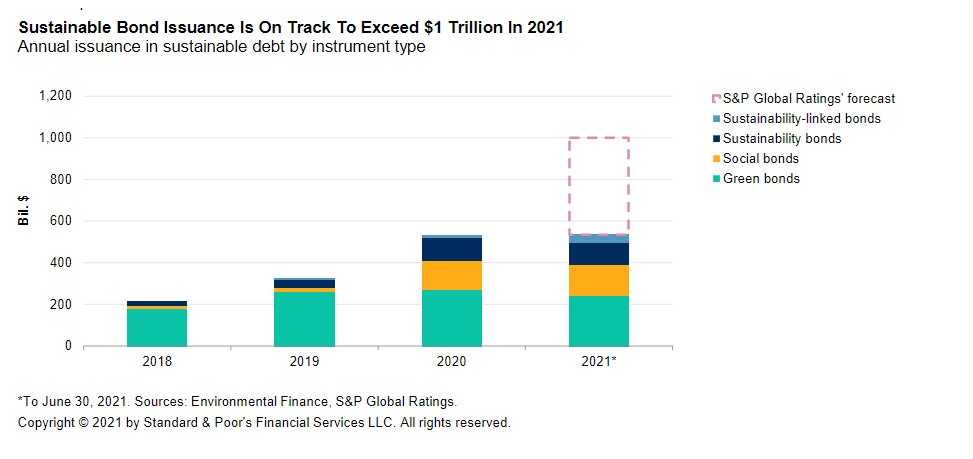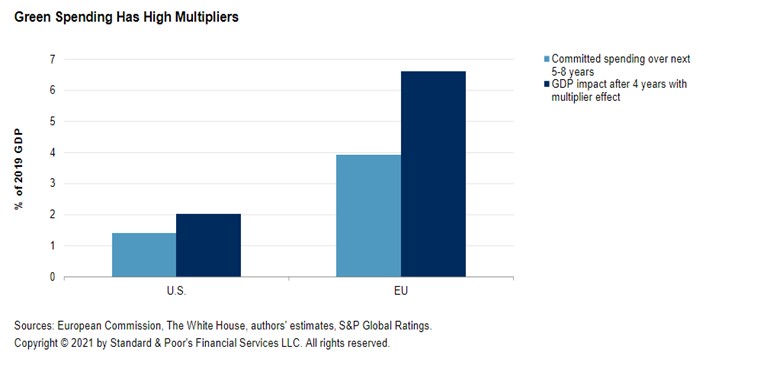Key Takeaways
- Financial institutions representing trillions of dollars have committed to tackle climate change but getting that money to the right place remains a huge challenge.
- Public policies and private financing must converge to get money flowing into sustainable finance.
- Green public spending will lift U.S. and EU GDP and encourage private investment in the transition, research from S&P Global Ratings shows.
A key theme emerged during the 26th U.N. Climate Change Conference in Glasgow, known as COP26: There is ample supply of financing to tackle the economic impact of climate change, but the world currently lacks the means of getting that money where it’s needed. This means that coordinated action is necessary between the public and private sector to finance the transition and map a new approach to funding and financing climate-friendly projects.
It's no secret that the world is going to need a lot of money to avoid a climate catastrophe. Limiting warming to 1.5°C relative to preindustrial levels by 2050 will require $3.5 trillion annually in investment, according to a 2018 estimate by the Intergovernmental Panel on Climate Change. And that means annual investment in low-carbon energy technologies and energy efficiency needs to be increased by more than five-fold by 2050 compared to 2015 levels.
The Glasgow conference has been touted as the “last best chance” for addressing climate change because it marks the five-year deadline for countries to update their climate goals agreed under the 2015 Paris Agreement. Those objectives were not ambitious enough to put the world on a path to limiting global temperature rise to 1.5 degrees C relative to preindustrial levels, the target that scientists say the world must hit to avoid the worst-case climate change scenario. Given the urgency of the task, there has been a real sense that money must be put squarely on the table if those goals are to be met.
“Make no mistake, the money is here if the world wants to use it,” Mark Carney, UN Special Envoy on Climate Action and Finance, said at a Nov. 3 COP26 session on the financial system and net zero. Carney is also chairman of the Glasgow Financial Alliance for Net Zero, or GFANZ, a coalition of more than 450 banks, insurers and investors.
COP26 delivered big headline commitments. Most notably, in a progress report, GFANZ said its membership had expanded to represent $130 trillion in total assets from $70 trillion at its launch in April 2021. Members must commit to being net zero by 2050 using science-based targets and must review their goals every five years.
Only mainstream finance can fund the estimated $100 trillion of investment needed over the course of the next three decades for a clean energy future, Carney said. But that can’t happen without the right government policies in place.
“Finance can fund investment driven … by credible, predictable government policies,” Carney said. “Such initiatives give finance the confidence to invest, point forward the adjustments in our economy, smoothing the transition to net zero and critically driving growth and jobs upwards while they drive emissions downwards."
Countries must develop ambitious new climate plans, Carney said, adding that there was a need to create new structures of blended finance combining private and public funding.
In the penultimate days of the conference, countries were negotiating whether to strengthen national commitments on carbon emissions reductions. The International Energy Agency estimated on Nov. 4 that the updated Nationally Determined Contributions, or NDCs, together with the Global Methane Pledge, which aims to cut global emissions of methane by at least 30% below 2020 levels by the end of the decade, could together help keep temperature increases to just 1.8°C by 2050.
To meet those NDCs, a key issue will be finalizing Article 6 of the Paris Agreement, which establishes a framework governing international carbon markets. The article is one of the unresolved elements of the Paris "rulebook" that sets out the terms of how governments can trade emissions reductions to help meet climate targets. Negotiators were still working out the final details of implementing Article 6 on the conference's last day, Nov. 12.
Carrying out Article 6 successfully would allow nations to leverage carbon markets as they seek to reduce emissions to net zero. It would boost the market for voluntary carbon offsets, used by companies to offset emissions, and unleash a wave of investment and liquidity in a market that is tipped to grow by a factor of at least 15 by 2030, according to the Taskforce on Scaling Voluntary Carbon Markets.
The financial industry has attempted to show that it is stepping up to the challenge at COP26. The CEOs of more than 30 financial institutions with more than $8.7 trillion of global assets pledged on Nov. 2 to eliminate investment in activities linked to deforestation. Europe’s largest asset manager, Amundi, along with the World Bank Group’s International Finance Corp., announced on Nov. 3 plans to establish a new $2 billion emerging market sustainable bond fund to finance climate-friendly COVID-19 recovery plans.

Green finance has grown exponentially over the last few years and appears poised to continue expanding. S&P Global Ratings, the ratings arm of S&P Global, predicts that sustainable bond issuance — including green, social, sustainability and sustainability-linked bonds — could collectively exceed $1 trillion in 2021.

And new research by S&P Global Ratings finds that government spending on green projects in the EU and the U.S. will lift GDP. Government spending on sustainable investments often takes place in infrastructure projects, which attract private sector financing, and green fiscal spending will encourage more private investment.

The challenge of financing net zero goals of developing nations
The climate transition could also present growth opportunities for developing countries. India, one of the world’s largest carbon emitters in absolute terms, announced during COP26 that it will become net zero by 2070 — a move that could create over 50 million jobs and boost the economy by $1 trillion by 2030, according to a report by the World Economic Forum.
COP26 brought into stark relief the need for better synchronization between developed and developing nations.
Two thirds of absolute emissions come from developing nations, though in terms of emissions per person developed countries’ emissions are much larger. Developing nations will need $1 trillion annually to fund the transition, which will require large-scale private sector investment, according to Mari Pangestu, World Bank Managing Director of Development Policy and Partnerships. At COP15 back in 2009, developing nations were promised $100 billion annually from developed nations by 2020 to tackle climate change.
But that amount has yet to materialize, and much of what has been delivered is in the form of loans, adding to the debt burden of already financially strained economies. A report from the Organization for Economic Cooperation and Development in September 2021 showed that climate finance for developing nations totaled just $79.6 billion in 2019.
One of the goals of COP26 is to ensure the $100 billion target is met, albeit much later than initial plans, in 2023.
A United Nations Environment Programme report published during COP26 estimated the annual climate adaptation costs for developing nations in the upper range of $140 billion to $300 billion by 2030, and $280 billion to $500 billion by 2050. Examples of adaptation include building flood defenses, or growing crops that are more resilient to drought.
One concrete example at COP26 of developed nations funding developing nations is a partnership between South Africa and Western nations. South Africa will receive $8.5 billion over the next years to phase out coal through a partnership with the governments of the UK, the U.S., France, Germany as well as support from the EU.
But for now, effective mechanisms are lacking to get blended finance moving quickly and at scale.
“There’s not a system today where private capital can be rapidly deployed,” whether it be in developing or developed countries, Larry Fink, chairman and CEO of the world’s largest asset manager, BlackRock, told COP26 participants.
Fink said “a union of public and private” is needed to quickly put capital to work financing climate change.
The public-private partnerships that emerged to rapidly develop and roll out COVID vaccines during the COVID-19 pandemic can serve as a model for combatting climate change, Fink said.
“We could actually do this for climate, but we can’t just cherry pick and greenwash by asking the public companies, the convenient companies to move forward, without asking all of society to move forward,” Fink said. "We need to reimagine finance. We have the most magnificent global capital markets we ever imagined. We can make it happen if we do it together."
This piece was published by S&P Global Sustainable1 and not by S&P Global Ratings, which is a separately managed division of S&P Global.


